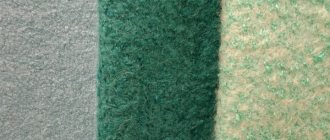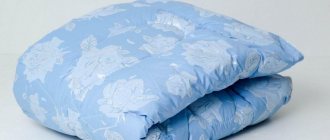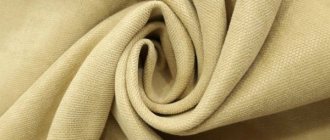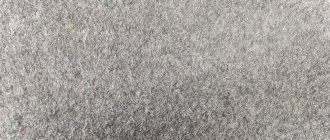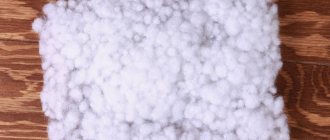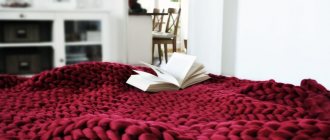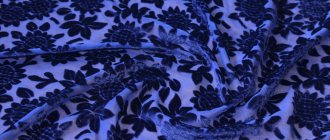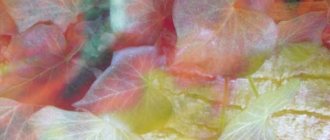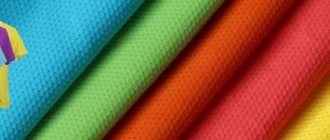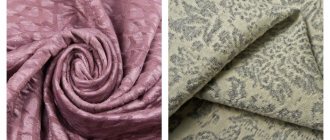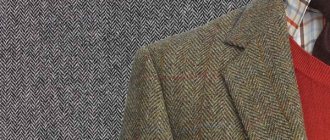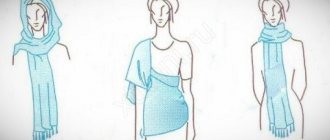What type of fabric is this?
Merino sheep are a breed of sheep that are bred for their wool. It consists of thin soft fibers, between which there are air cavities. Merino pile is 1.5-2 times thinner than that of ordinary breeds.
Various colors of merino fabric
Merino wool is not only very warm, but also durable. Unlike ordinary sheep's wool, it does not prick and does not irritate the skin.
Light and warm fabric is made from wool yarn. Its natural shade is white or light beige. Sometimes it is left to emphasize naturalness, in other cases it is painted.
How to distinguish a fake from the original
When purchasing yarn in a store, pay attention to the structure of the thread. Real wool is not itchy, light, soft, and difficult to tear. When ordering a product or wool online, watch video reviews.
Natural merino has a slight odor, not similar to sheep.
If you rub several threads at the same time, the wool does not squeak. When you hear a slight crunch, synthetics are added. If you set fire to real fiber, it burns rather than melts. You can smell burnt horn. The fake product emits an unpleasant odor when wet.
The color of merino wool has a uniform texture. The canvas does not contain any irregularities or knots.
Linen is indicated as merino ull, shoeller wool, merino wool. What it is? Pure merino, merino wool.
Was this article useful to you?
Origin story
Wool has been known to mankind since ancient times. It is knitted, felted, woven. Clothes made of woolen cloth were already known in Ancient Rome.
The Merino sheep breed originated in Spain. It is believed that it originated from sheep brought from North Africa and Asia Minor. In the XII-XVI centuries. Spain was famous for its quality wool and even supplied it to England and Flanders.
Until the 18th century, exporting sheep from the country was prohibited, but later the breed spread throughout the world. Today, the leader in the production of merino wool is Australia (up to 80% of the world market). The material is produced in many European fabrics, Italian is especially popular.
Fabric composition and its properties
Merino wool is very fine (thinner than human hair), and there are tiny air cavities between the fibers.
This combination makes the fabric incredibly warm and soft. The fleece is covered with a natural lubricant - lanolin. Thanks to this, the material is durable and elastic.
Lanolin is credited with medicinal properties. Wearing merino items is recommended for arthritis, radiculitis, edema, bronchitis and bronchial asthma.
In addition to 100% merino, materials with various impurities :
- synthetic fibers reduce cost and increase resistance to aggressive influences;
- some artificial fibers add elasticity (elastane, lycra);
- the admixture of other types of wool (for example, alpaca) makes the fabric denser and stiffer;
- silk adds smoothness and shine.
A combination of several components is possible. For example, merino, alpaca and polyester. Or polyamide, merino wool and silk.
Types of fabric
Merino wool fabric varies in thickness, purpose and production features:
- gabardine is a durable material that is distinguished by its twill, or diagonal, weave of threads and water-repellent properties;
- flannel - soft, light and velvety, with double-sided brushing;
- stretch - with the addition of 2-5% elastane, fits the figure better and wrinkles less;
- knitwear is a soft fabric that makes clothes look informal;
- jersey - thick knitwear.
Types of Merino Fabric
Application
Merino extrafine is a high-quality sorted wool, so it is used for clothing and knitting yarn. The material is not the most expensive in its segment, but very popular.
The following are sewn from merino fabric:
- men's and women's suits, trousers;
- skirts, business dresses, sundresses;
- vests, jackets.
The fabric is rarely 100% merino; to improve consumer characteristics, up to 30% synthetics (nylon, polyamide) are added.
Pros and cons of fabric
Advantages:
- keeps warm;
- the fabric allows air to pass through, allowing the body to breathe under clothing;
- does not cause allergies;
- hygroscopic material (capable of absorbing moisture up to a third of the volume, so the body underneath remains dry);
- wool contains lanolin (animal wax), which is known for its restorative and anti-inflammatory properties;
- does not absorb odors (for example, sweat);
- pollution does not penetrate deep into the structure of six, but remains on the surface (things are easier to clean);
- Products made from merino wool last a long time if properly cared for;
- do not become electrified and do not stick to the body.
Flaws:
- difficult care;
- pellets appear;
- high price.
What kind of wool is there? Varieties
To obtain yarn, the pile is cut from the withers area. In this part the thickness is up to 20 microns. Curls form on the scruff of the sheep, which creates elasticity in the wool.
How yarn is marked:
- Strong – thickness 20 – 22.5 microns. Sometimes it reaches over 23 microns. Used in the production of machine knitting;
- Average diameter Medium - varies between 18 - 20. This type accounts for 14.6% of world production;
- Thin Fine – 16 – 17 microns. Market share 7%;
- Very thin thread with the designation Super Fine - 14 - 15 thickness. Wool, as light as feathers, is used to create expensive fabrics;
- Ultra-fine Extra Fine – diameter 12 – 13 microns. Due to its small population, it is considered a rare species. Sheep are walked in cloudy weather wearing special capes. It is possible to avoid tangling of fibers.
Magic properties, characteristics
Merino wool has good moisture absorption capacity, 30% of its own weight. It heats up to the temperature of the human body, absorbing water. This eliminates unpleasant sensations when coming into contact with the material. Bedspreads and clothes remain dry to the touch.
Suitable for sensitive skin. Does not cause allergic reactions, redness, or irritate it. Resilience, elasticity, and antimicrobial properties make it resistant to odor. Antistatic, fire-resistant features are the main advantages over synthetics. The creatine contained creates unfavorable conditions for the growth of bacteria.
Thermal insulation - air bubbles form inside the fibers, preventing the flow of cold from entering the body. For this reason, manufacturers fill sleep products with wool: mattresses, pillows.
Calming influence. Merino contains the substance lanolin, which softens the skin. In demand in cosmetology. Included in creams with a calming effect.
Self-cleaning - each thread has a core in the form of double cells that absorb moisture differently. If humidity increases, one fills with liquid, the second changes size. When they come into contact, friction occurs between them. Thanks to this property, the products do not require special care. Fresh air ventilation is recommended.
Electrostatic characteristics. Wool reduces positive ionization in the body, which depresses and causes illness in humans. Being a natural protein, it neutralizes toxic particles.
Merino is a special variety whose wool has long, fine fibers. Until now, scientists have not developed a breed that would be its analogue.
Warms, heals
Yarn has a healing effect on the entire human body:
- It has a beneficial effect on bones, joints, lumbar region, and improves blood circulation.
- The wax content has an anti-inflammatory effect. For people suffering from rheumatic diseases and bronchial asthma, it is necessary to wear wool clothing.
- Relieves fatigue and tension.
- Promotes good sleep, eliminates insomnia.
- Warms against colds and viral infections.
What are they sewing?
Manufacturers produce the following products based on merino wool:
- blankets, rugs;
- overalls, hats, tights;
- sweaters, turtlenecks, cardigans;
- thermal underwear: for athletes, daily wear;
- house shoes, insoles;
- outerwear;
- seat covers.
Merino blanket
The material is silky and smooth. The product is not susceptible to dust mites. To create a unique bedspread, the yarn is subjected to special processing:
- technical beating;
- manual sorting of fibers, removal of matted areas;
- painting taking into account technology;
- joining dyed threads into a composition;
- to achieve a homogeneous result, multiple carding;
- spinning.
Blanket sizes:
- children's version – 100 x 100
- one and a half – 150 x 200
- double – 170 x 220
- European - 200 x 220, 240
If you adhere to the rules of care, the blanket will retain its quality and shape for a long time. In hot weather it will protect against flies and insects. In winter it will keep you warm. Learn how to properly care for it:
- setting a delicate mode in an automatic machine;
- temperature regime no higher than 35 degrees;
- the use of aggressive chemicals and bleaches is prohibited;
- separate wash, without extraneous items;
- remove stains in warm water and laundry soap.
Thermal clothing
Linen made from merino wool is valued for its hygroscopicity and thermal characteristics. Can be worn on a naked body; no additional clothing items are required. Will warm you up during winter fishing, hunting, or outside in severe frost. The standard set includes a T-shirt and long johns. The assortment is complemented by socks, shorts, turtlenecks, and balaclavas. The advantages of the products are a wide range of temperature conditions for wearing, moisture absorption, and two-layer fabric.
slippers
Slippers are made from 100% wool. Stitched sole 8 mm, does not get wet, with anti-slip effect. Automatic washing is acceptable. Suitable for wearing in a private house or apartment. Warm the legs and provide dry warmth to the feet. They have a preventive effect, preventing diseases of rheumatism and fungus. They have no sweat smell. Everyday wearing of merino shoes reduces foot fatigue and improves blood circulation.
Pillows
Filling with sheep wool makes the pillow weightless. For those who like to sleep on a low, soft pillow, this is the ideal solution. During rest, the head is not in danger of hypothermia or overheating.
A wide selection of models presented in stores allows you to choose the right size. Designer design, taking into account your body type and preferences. Quilted covers are included.
What standards are used in production?
GOST 26383-84 defines the standards for merino wool.
Fine wool can be merino or crossbred. Moreover, the first one is soft, elastic and uniform, white in color. Merino wool is divided into classes according to thickness:
- 80ᴷ - from 14.5 microns
- 70ᴷ - 14.5-20.5 microns;
- 64-70ᴷ - 23-20.5 microns;
- 64-60ᴷ - 20.6-25 microns;
- 60ᴷ - 23.1-25 microns.
And according to the length of the fibers:
- I - from 70 mm;
- II - 55-70 mm;
- III - 40-55 mm;
- IV - less than 40 mm.
Watch the video about the production of merino wool:
How to knit a merino wool hat
To attract the attention of passers-by, wear a merino wool hat. Volumetric threads create a real work of art. This product looks good in tandem with a scarf. For the winter version, a knitted lining is used. To work, you need thick yarn, number 15 knitting needles.
Taking measurements:
- Head circumference.
- Depth from one earlobe to the other. Divide by two. Add six centimeters to the length of the lapel.
Knit a square with wool. Take a ruler and count how many loops there are in ten centimeters. Determine how many 10 cm rows there are. The resulting numbers are the density from which the initial set for the circle is calculated.
Description: head circumference is 56 cm. A set of sixteen loops will be required. Using circular rib knitting needles one on one, make eleven rows. From 12 we begin to decrease, going to face knitting. To do this, make one purl and then a knit stitch. Three rows are knitted in this way. Then cut 15 cm of thread. Pull the thread through the loop and tie a knot tightly. Ready.
What purposes can this fabric be used for?
Made from merino:
- suits, warm dresses and skirts;
- blouses and turtlenecks (from mixed fabrics);
- outerwear (coat, etc.);
- hats;
- thermal underwear;
- scarves;
- children's clothing (including for newborns);
- blankets and blankets that can keep you warm in winter;
- pillows with such filling, unlike synthetic ones, do not cause allergies.
Merino wool items
Care Tips
The delicacy of clothing requires careful, gentle care. Do not store items in a plastic bag. The best option is a box, paper packaging. This way the original appearance and form are preserved.
Before storing a wool sweater or dress in the closet, do not fold it. Hang it on a hanger so that it is in the straightened position. When storing blankets, use vacuum bags.
Handwash
Take the product, put it in a bowl, a bath with water at a temperature of 30 ° C. Add shampoo, a chemical designed for this type of fabric. If necessary, use dishwashing liquid. Do not use softening liquids or bleach. Leave the wool to soak for three minutes. Rinse several times with warm water. Strong twisting is not allowed; squeeze slightly. If possible, take it to the dry cleaner.
The wet item is dried by laying it on a towel. Placement on heat sources and radiators is not allowed. If necessary, comb the pile while wet.
In the washing machine
It is advisable to avoid washing oversized sweaters in a machine. Socks, hats, and mittens retain their shape better when machine washed. To avoid thread fraying, wash items inside out. Select a specific mode with a minimum drum rotation speed. Place the product in a dry towel and roll it up. This will remove excess moisture.
Do not remove the formed pellets from the surface with your hands. Cut with scissors; this will not damage the product.
Ironing - through cotton fabric, on minimum heat setting.
If the wool has acquired a yellowish tint, keep it in a container with half a lemon added.
If the item sheds while rinsing, add a spoonful of salt.
